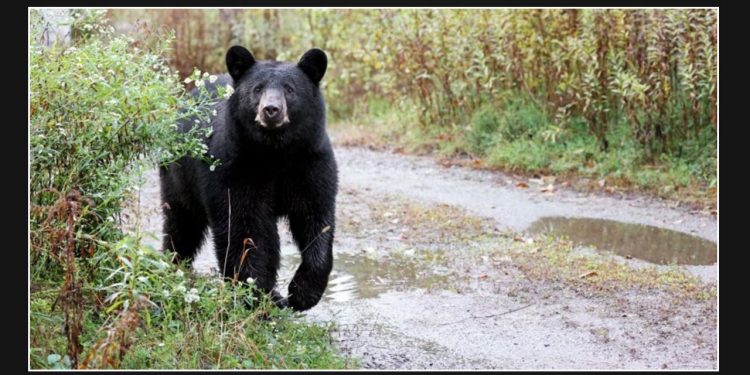It’s not every day you expect to come across black bears in Kansas, but it seems sightings of the animals are on the rise in certain parts of the state.
We contacted Matt Peek, a wildlife and research biologist at the Kansas Department of Wildlife and Parks (KDWP), to gain an expert’s insight on the black bear activity in the state. According to Peek, although bear sightings are still uncommon, they are not as infrequent as they used to be.
Confirmed black bear sightings in Kansas
This Article Includes
According to Peek’s written response to 27 News, there have been a total of 10 confirmed sightings of black bears since 2015. In contrast to other large predator sightings, such as mountain lions, which can easily be mistaken for other animals, black bears tend to be quite noticeable and easily detected. In fact, multiple bears have been documented on several occasions while in Kansas.
According to Peek, bears were a rare sight in Kansas before 2000. However, since then, annual visits from black bears have become a common occurrence in the southwest region of the state. It seems that these bears make their way back to their established ranges in other states by the fall. In the past few years, there has been a surge in bear visits in southeast Kansas, which is in line with the increase of bears in neighboring states such as Missouri and Oklahoma.
In Kansas, black bears are commonly found in two regions – the southeast and southwest corners of the state. These areas are located near established black bear populations in neighboring states.
According to the Kansas Mammal Atlas in partnership with Fort Hays State University (FHSU), it is believed that the black bears spotted in Kansas are typically young bears who have migrated from neighboring states such as Missouri, Arkansas, Colorado, and Oklahoma. These sightings are more common during the summer months when the juvenile bears venture out in search of food and new habitats.
According to Peek, there are no bears that reside in the state throughout the year. He stated that the majority of confirmed bears are yearlings that are identified between May and July, which is the time when they leave their mother and wander away from their birthplace. Peek also mentioned that sightings outside of this period are uncommon, and there have been no records of cubs in recent times.
Peek at FHSU confirms sightings and reports of black bears in Kansas through the use of game cameras capturing video footage and photos. It’s possible that some sightings may be of the same bear, seen multiple times by different people. The current list of sightings and observations for black bears in Kansas, recorded mostly after 2000, is as follows:
-
- Bourbon – 1
- Chautauqua – 1
- Cherokee – 5
- Crawford – 7
- Doniphan – 3
- Douglas – 1
- Greeley – 1
- Hamilton – 1
- Labette – 2
- Mitchell 1
- Morton – 3
- Saline – 1
- Stevens – 1
According to FHSU, black bears that have been spotted in Kansas do not tend to remain in the area, and there is no fresh evidence to indicate the presence of a permanent wild population in the state. The most recent sightings were reported in 2021.
Should people be worried?
According to Peek, there haven’t been any recent reports of negative interactions with black bears in Kansas. Although bears, including grizzlies, were previously abundant in the eastern regions of Kansas, they were forced out by the late 1800s. Despite this, the KDWP provides online resources to assist individuals who have concerns about the presence of black bears in their vicinity.
According to Peek, encountering a black bear in Kansas shouldn’t be a cause for concern as they are still rare and mostly found in the southern regions of the state.
If you’re looking for more information on coexisting with black bears, Peek suggests checking out the website BearWise, which is in partnership with the KDWP. Created by biologists, the website offers valuable tips on how to live near black bears, avoid bear encounters, and what to do if you happen to come across one.
According to Peek, living with black bears often entails making some changes since they are naturally drawn to food sources. These may include bird feeders, bee hives, chicken coops, stored grains, BBQ grills, and unsecured trash, among other things. Individuals may need to alter their habits to coexist with bears. Sadly, a few people who are unwilling to make the necessary adjustments may resort to killing the bears, potentially slowing down or even preventing their establishment in the state.
According to the KDWP, it is not permissible to kill large predators like bears, mountain lions, and gray wolves in Kansas without any valid reason. However, landowners are allowed to eliminate wildlife, including black bears, that are found inside or in the proximity of their buildings or when they are damaging their property. Nonetheless, prior to taking any such action, substantial measures must be taken to mitigate the situation.
How to report black bear sightings
If you believe that you have evidence of black bear activity in Kansas, you can report it to the KDWP by getting in touch with their Emporia Research and Survey Office at 620-342-0658. The evidence can include videos, photos, as well as tracks.
To share your black bear sighting with 27 News, simply follow this link and upload your captured footage.
Read More:
- An Ohio man receives a sentence for a series of robberies and distribution in western PA
- Woman, who gave birth behind a food truck while she was working and had to throw her child away because she didn’t want her boyfriend to Ieave her

